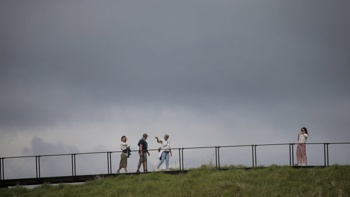An ocean-atmosphere state primed by La Niña.
Coastal waters warmed by relentless marine heatwave conditions.
A warm, moisture-packed subtropical low-pressure system bearing a long band of thunderstorms, with little room to move or take on more water.
A ribbon of strong wind – notably seen in 2017′s “Tasman Tempest” - that glided just above the surface and siphoned rain straight into the city.
And of course, behind it all, the increasingly influential elephant in the room that is global climate change.
Auckland’s wettest day in history was driven by what experts are calling a freak combination of elements, making it a standout event even when set against major deluges of our last three years under La Niña.
The economic fall-out from this disaster – which put our largest city underwater with an entire summer’s worth of rain in just one day – could well prove unprecedented for a single New Zealand weather event.
One expert suspects it’s likely to have reset the national conversation about the climate crisis upon us.
“This is a massive event that’s hit our biggest population centre ... houses and roads have been damaged and at least one person has died,” Victoria University climate scientist Professor James Renwick said.
“But we’re going to see more of these events, unless we can get on top of emissions and stop the climate from changing.”
/cloudfront-ap-southeast-2.images.arcpublishing.com/nzme/GFT572IF45CQPGAQZG7VBSQXCY.png) Firefighters use ropes to help rescue residents trapped by flooding in Ranui, West Auckland. Photo / Hayden Woodward
Firefighters use ropes to help rescue residents trapped by flooding in Ranui, West Auckland. Photo / Hayden Woodward
The scale of last night’s downpour has surprised even meteorologists who’d been tracking the system throughout the week.
Last Sunday, forecasters were speaking of a “subtropical disturbance” that had the potential to bring rain to Northland, and perhaps to parts of Auckland, over the holiday weekend.
By Thursday, MetService was warning Aucklanders of potentially heavy rain arriving on Friday night.
Then, around the time concert-goers began making their way to Elton John’s show at Mt Smart Stadium, it became clear this wasn’t an ordinary rainmaker.
Across the city at Auckland Airport, it’d been raining steadily throughout the day, with around 70mm recorded between sunrise and early evening.
The next four hours brought totals twice that - including a whopping 71mm observed between 8pm and 9pm alone and another 60mm in the hour following – leaving the airport’s terminals flooded with shin-high water.
By 10pm, provisional totals showed it’d been Auckland’s wettest day in recorded history for a raft of locations – with 238.4mm at Motat, 260.6mm at Albany and 242mm at Mangere.
“Until now, Auckland’s wettest January was in 1986 with 206mm, but already in January 2023 we have had an extraordinary 320mm of rain at Auckland Airport,” said meteorologist Lisa Murray of MetService, which has issued its worst-event Red Warning.
“In addition, it looks like Auckland is having its wettest month ever since records began,” she said, adding totals now topped July 1998, when 304mm fell over the month.
Even earlier on Friday, when Renwick logged on to check the latest satellite observations, the low pressure system bearing down on the North Island didn’t strike him as unlike a thousand others he’d seen.
“It wasn’t especially dramatic,” he said.
“But I guess the big thing with this was the amount of moisture it was carrying - the air within it must have been very, very unstable.”
It was.
Niwa Weather’s Ben Noll was closely tracking the storm as a raft of major elements dramatically began to converge.
“It’s kind of a cliché, but this was very much a perfect storm,” said Noll, who was fielding overseas media calls into the early hours of Saturday.
“There were some indications that it was going to be bad, but it turned out to be very, very, very bad.”
One early warning sign was a large area of converging northeasterly winds, which set up an intense rainband and enabled convection – the transport of heat and moisture – to quickly develop.
“That convection then ran right across Auckland and produced extraordinary rainfall intensities,” he said.
“As this was happening, from the ground right up to the jet-stream at around 250 hectopascals, there was basically no part of the atmospheric column that wasn’t completely saturated.”
But it proved to be a long band of thunderstorms - squeezed within this moisture-charged system and unable to take on any more water - that unleashed those powerful evening bouts of torrential rain that long-time Aucklanders said they hadn’t seen before.
Noll cited some other clear factors.
One was that the northerly low had run up against a large blocking high to the southeast, which helped slow the system as it dumped rain over Auckland.
“It really stymied this low’s progression and forced it to move slowly over Auckland.”
Another was a low level jet - a ribbon of strong wind in the atmosphere positioned not far above the surface - which funnelled in yet more warmth and tropical moisture.
Noll had seen this happen before – notably in March 2017′s “Tasman Tempest” that brought Auckland’s wettest day in nearly 60 years.
In that case, a low-level jet formed on the eastern flank of a low positioned to the northwest of Auckland, before funnelling rain directly into the city – and history likely repeated last night.
A third component were seas that had been running warmer than average for much of the last three years, but particularly now at the height of summer, amid another marine heatwave event.
That warmer water likely energised the system further as it passed over, Noll said.
“You’ve got a subtropical low coming into the New Zealand region, where oceans have been recently running as much as 4C to 6C warmer than average – not to mention that it’s also been much warmer up in the Coral Sea,” Noll said.
“I just don’t think we would have achieved these outcomes if our seas were running average or below average.”
Finally, he pointed to the two big background players hovering over the picture.
One was La Niña, the ocean-driven system that’s been meddling with our weather and climate since the start of the decade.
It’s shaped a dramatic contrast in local conditions across New Zealand – helping push parts of the South Island to the verge of drought, while making for Northland’s rainiest summer yet – but has generally delivered widespread rain and warmth.
Coupled with local marine heatwave conditions, its dominance has coincided with New Zealand’s two latest warmest years on record (2022, 2021); three back-to-back record warm winters (2020, 2021, 2022); our wettest year (2022); and a slew of local rainfall records.
While New Zealand has experienced La Niña around a dozen times in the last 50 years, the effects we’re seeing now are unprecedented.
That’s down to another giant influencer that’s now unignorable: climate change.
In just 111 years, the average temperature has risen by more than 1C, with the starkest changes have coming within the last three decades, in which the pace of warming has tripled.
In particular, warming sea surface temperatures - as have been observed across the Southwest Pacific and Tasman Sea over the past seven decades – translated to more water vapour.
As air warmed, its capacity to hold water increased at an average 7 per cent per 1C of temperature rise.
Because warmer air could carry more moisture, this in turn allowed more evaporation from the oceans.
“And when you’ve got a storm, you’re really concentrating all of that moist air,” Renwick said.
Thus, we could expect downpours to become more intense, at a time the world was tracking toward more than 2C of temperature rise.
“When it rains, it tends to rain harder – and occasionally, you’ll get something like we saw yesterday, which I’d emphasise was still a quite an extreme event.”
Over recent years, climate scientists have been teasing out this influence in high rainfall events through what’s called climate change “attribution”.
This involved comparing models that simulated a world in which greenhouse gases hadn’t altered the climate, with models that simulated what was observed in reality.
They’ve already estimated the extreme rainfall that caused Canterbury’s flooding in 2021 was 10 to 15 per cent more intense because of human-driven climate change - with a similar-sized influence also observed in that year’s Westport disaster.
“I’m absolutely sure that with this event, there’ll be a climate change contribution that means we otherwise wouldn’t have had as much rain,” Renwick said.
He expected the deluge would prompt new discussions among civil engineers over the state of our infrastructure.
According to New Zealand’s most recent risk assessment, 72,065 people live in areas exposed to once-a-century coastal inundation flood risk, while about 675,500 live in areas prone to inland flooding.
But those figures are almost certainly underestimates.
One major recent sea level rise study found that, in vast swathes of our coastline, one-in-100-year extreme flooding could become an annual occurrence within two decades.
Last year, the Government released its first climate change adaptation plan, packed with more than 120 actions to be carried out within six years.
This disaster may also prove a paradigm-changing moment for our insurers, which paid out a record-high $335.58 million for extreme weather claims in 2022.
Some have already introduced risk-based pricing for properties vulnerable to flooding, with one expert recently warning policy-holders in seaside areas at risk of one-in-100-year flood events could lose cover within their lifetime – perhaps even in the next 10 years.
Considering one estimate of the current rateable value of exposed residential property, $17 billion worth of homes could be at risk.
More generally, Renwick hoped this event would shift our national discussion on climate change.
“I know from experience that extreme weather events happen, then a month passes, the sun’s shining, and people tend to forget pretty quickly,” he said.
“I’d like to think that this storm will help to change the conversation.”
Take your Radio, Podcasts and Music with you









